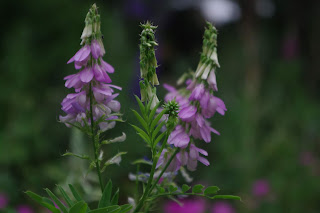A diary of back garden botany, urban ecology, rural rambles and field trips to the middle of nowhere...
Friday, 29 June 2018
Both the beneficial and dangerous properties of plants are apparent in this grouping in the garden (though that wasn't my intention when I planted them). In the foreground of the photograph above are the cheery yellow and white Daisy-like flowers of Feverfew (Tanacetum parthenium), and it is indeed of the Asteraceae i.e. Daisy family.
Beyond basic botany I don't really address herbalism or modern medicine in this blog because I am not versed in either subject. Feverfew is interesting in this respect because traditionally it was regarded as a medicinal herb for headaches, colds, rheumatism, fevers and such; hence the name. It has also been the subject of a number of modern studies which agree that it can have a beneficial effect on conditions such as migraines albeit with the proviso of possible side effects in some cases e.g. if consumed by pregnant women.
Continuing with this theme in the middle ground of the photo we see the lilac flowers of Goat's-rue (Galega officinalis):
In folk medicine Goat's-rue was advocated for symptoms which we now associate with conditions like diabetes (and also to increase the yields of milk). Observation and study led to the conclusion that G. officinalis has adverse and somewhat toxic effects on humans but research continued into the compounds of the plant and derivatives from these became the basis of several modern drugs developed to tackle diabetes.
As I understand it numerous modern medicines are synthesized from plant compounds yet there is a schism between advocates of "herbal" and "scientific" medicine. I can't help wondering if there couldn't be some common ground on both sides of the argument?
On a cautionary note however in the background of the first photo we see the blue-indigo flowers of Monk's-hood (Aconitum napellus), a beautiful plant but poisonous:
There are a good many plants popular in gardens and growing wild that have toxic properties- Foxgloves, Lily of the Valley and Delphiniums for example. Monkshood must be one of the most toxic. Eating any part of the plant would induce severe sickness and possibly be fatal. Apparently it tastes very unpalatable which is a warning of sorts though there have been rare incidents where it has been consumed with dire consequences.
There was a tragic case widely reported a few years ago where a young man working as a gardener died from organ failure, and this was said to be a consequence of brushing against Monk's-hood.
It was not widely reported that an open verdict was recorded at the subsequent inquest into the death of this unfortunate person and in fact the cause could not be determined. Various experts have expressed the view that Monk's-hood poisoning was not a viable explanation for what happened.
There are accounts of incidents where florists have experienced nausea and other symptoms from skin contact when handling it but as far as I'm aware there is no plant so toxic that merely touching it will prove lethal.
None the less Aconitum napellus is a reminder that plants have a very diverse chemistry. Some are nutritious, some can be medicinal but some have the potential to be harmful.


